It’s March – and we’re all a little mad. The sun is shining, and the dreariness of wintertime is starting to melt away.
Hello! So, how are you doing? Are you hanging on, with all that’s going on in the world? Maybe you’ve started walking or riding the bicycle given the slightly better weather?
Moving
Moving in the literal – walking to the store and so on. Figuratively – moving on – masks and all – despite the madness of coronavirus.
So, instead of dwelling on “that” subject, let’s jump in our cosmic spaceships and travel back to the Middle Ages.
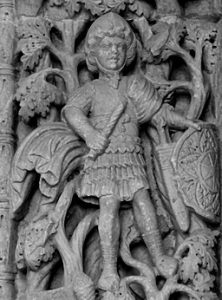
MEDIEVAL CALENDAR
We have all heard about the Chinese New Year, which follows the Lunar Calendar.
There is also the Julian calendar, which is used in the Eastern Orthodox faith, and the good ol’ Gregorian calendar, which we use here in the west for 99% of our activities.
In different cultures around the globe, there are definitely more – I was once told that Indonesia uses no less than five calendars, interchangeably, and that no one gets confused! Amazing!
MARCH USED TO BE NEW YEAR.
March Madness in the US usually refers to sports, but we get mad here all by ourselves.
Just like the zodiac, it all begins with the sign of Aries, and … until about 500 years ago:
New Years Day was none other than – March 25.
March 25! What a random date!
It may seem like it, but, it’s not random…
March is exactly nine months before someone’s birthday… I wonder whose…(here’s a hint – it falls on Christmas).
THE CALENDAR – CARVED IN STONE
A very lovely depiction of this calendar can be seen – of all places – on the entrance of St. Lawrence’s (Sveti Lovre) Cathedral in Trogir.
As you can see in the picture, there is a lot of stonework here. We are interested in the second concentric row from the center.
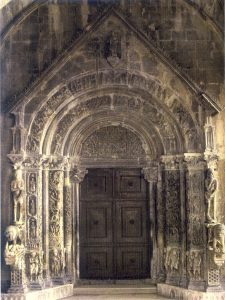
Late March, or Aries
From the bottom right-hand corner of the entrance, carved in fine white marble, you can see wild little Aries. Besides the March zodiac sign, he represents – March Madness!
Late April, or Taurus
Right over his head, you can see the symbols for the next month of the year – Taurus – and there is a bull sitting behind the man’s head, as he shears the wool from his sheep.
Late December, or Capricorn
On the left side of the arch, you can see a man chasing a pig, with a tall elk behind him – that’s Capricorn. These carvings are a masterpiece, but it is interesting that the greater the master, the more respect he shows for the common people.
Late January, or Aquarius
In the next carving – that – tells – a story, you see an old man, sitting by the fire, warming his feet and cooking sausages (from the pig he slaughtered the month before)! His servant is pouring something into his cup – yes, that is an analogy for Aquarius.
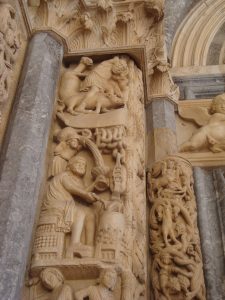
Late February, or Pisces
On the lowest picture on the left-hand column, you will see a man planting his crops. There are dead fish being placed in the ground to act as fertilizer, and this is the depiction of Pisces.
Unfortunately, his masterpiece was never completed. And who is “he”, after all?
MASTER RADOVAN
People ask – who made these amazing carvings? Why isn’t he known, like Leonardo da Vinci, or Michelangelo?’
There are several reasons. We are not sure of his name… but we have a clue. For all intents and purposes, we call him RADOVAN. But how do we know this?
I will tell you how. This Cathedral is made in the Gothic style – which means that everything means something else. Just like your friend who likes to make puns. (NOTE: Trogir was designed and built by the Ancient Greeks. It was a walled city, well over 3000 years old, and its streets are perpendicular to one another. This remnant from the past offers samplings of Romanesque, Gothic, Venetian, and even traces of Ancient architecture dating back to the 5th century at St. Barbara’s church, near the Loggia.)
THE PORTAL TELLS THE TALE
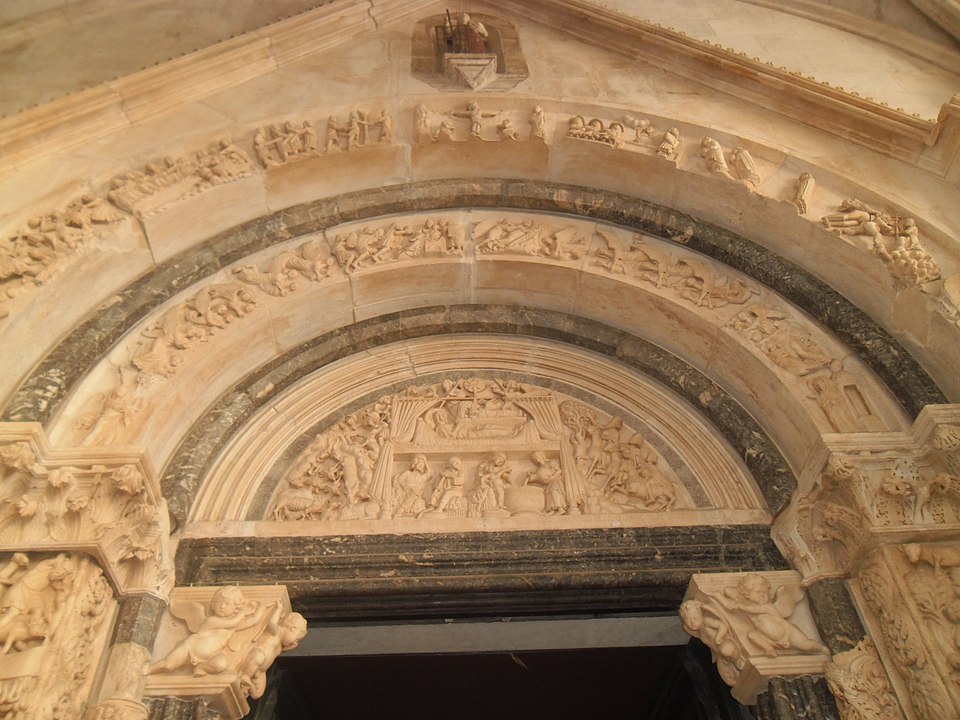
If you look at the half-crescent-shaped portal above the door, there is a carving showing many stories combined into one space. The Holy Family is there (Mary, Joseph, and Jesus); the Three Kings on their camels; you will notice shepherds and sheep, and so on. There are 33 figures in total, just like the number of Jesus’ years on earth (Gothic!). Oddly, not a single figure is looking directly forward towards the viewer. Except for one – and that is the ram. This “lusty” character is looking directly forward with a piercing look. Right below, the word “Radovan” is inscribed.
Radovan had a good sense of humor!!
If you are wondering about Adam and Eve, they were added later (not by Radovan) probably inspired by the Tree of Good and Evil in the portal; the lions probably refer to the Venetians who were here for a few hundred years, and so on. The men at the base of these carvings are known as the miserable ones, and they don’t look too happy with their job of holding up these extremely heavy works of art.
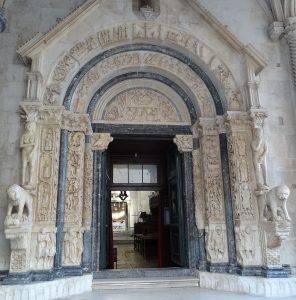
Whatever happened to Radovan? To this day, historians simply don’t know.
As a master builder, he might have found a better job offer in another country (ie. Spain or Italy, perhaps). He might have fallen off a ladder or died of the plague. In those days, people did not use last names. You were Radovan from Split, for example, until you moved. As these artisans were used to moving around for their work, it is a little hard to trace. Radovan itself means “Happy, working person”.
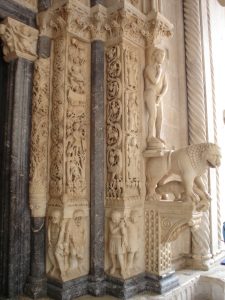
By the way, these masterpieces were recently cleaned up just a few years ago (in the 1980s) due to laser technology of cleaning the dirt and grime from the limestone carvings.
We hope, down the road, to discover more hidden works by Radovan.
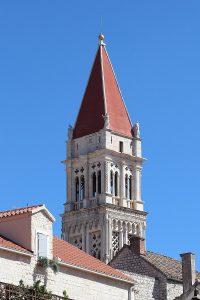
“War is declared every day in Trogir at noon”
Those bells are LOUD!
Note: This church and its gorgeous belltower were built in the 13th century, in the days of Ghengis Khan.
Characters from the past
In fact, his nephew and heir very nearly invaded Trogir in search of King Bela IV of Hungary who, along with his family, was hiding in Trogir.
The situation was a bit tense, to say the least. After a seven-day standoff with soldiers shouting at the entrance, they finally gave up and galloped off. It wasn’t what the invaders had planned to do, but it seems that Genghis Khan was lying on his deathbed and wanted his nephew back home asap.
Some say it was a miracle. The townsfolk attribute it to their beloved Saint John (Ivan), who they prayed to during this impending invasion. St. John was a bishop in Trogir, later canonized for his many good deeds.
Back into our spaceships… we are re-entering the Present…..
WHY YOU FEEL SO DARNED TIRED IN MARCH
Why are you tired? Because the sun in March is very high in the sky, direct, and because each day is gradually getting longer.
It is also the season when, traditionally, farmers went to the fields to clean their vineyards of freshly sprouting grass and other weeds that threatened to invade their crops. (Remember Radovan’s carvings for April). Sheep – that means new baby animals being born, Easter, fieldwork, fresh eggs, milk, sirnica (Easter bread) and cheese after the long winter hiatus aka dead season.
How to navigate the season
According to the folk wisdom of Dalmatia, the best way around it is – go to bed at 10 or 11.
This time of year, people eat a lot of seasonal veggies, like asparagus, artichokes, blitva (mangold/swiss chard) with olive oil and garlic, spinach, and other light meals (as well as dairy foods) to not feel too weighed down.
Get up early and work, and as a result, you’ll find it easy to catch a nap in the afternoon. What if you don’t own your own plot of land to till? You can always have a glass of “biwanda” after the midday-meal – it consists of half water and half wine – preferably red wine, domestic!

Dalmatian Siesta
This routine will help you get through the summer, too, and not be too tired to enjoy the summer festivals, free concerts on the Riva or town square, and so on. Early am, shop or swim, come home, prepare lunch, eat, sleep.
In the afternoons, the older generations play Bocci Ball (lawn bowling), sit in the park, younger people walk the dog, meet for coffee: basically – do whatever you like… but be asleep by midnight most nights so you can enjoy every drop of sunshine.
Radovan would have approved.
Kind Regards from Amerikanka in Croatia!
Anastasia
![Expat [DESTINATIONCOMPLETE]](http://www.expat.com/logo/logoExpatBlog.png)
Recent Comments